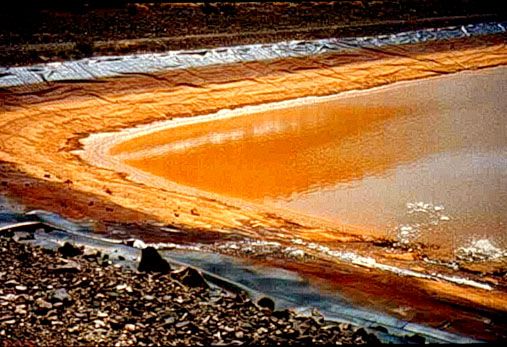Biological Water Treatment for Mine Impacted Water
Published on by Water Network Research, Official research team of The Water Network in Technology
In a bid to conserve the increasingly scarce resource, Mintek is currently developing and testing solutions to treat mine-impacted water, as well as acid mine drainage (AMD).

Acid mine drainage, Source: Wikimedia Commons
The case for active and passive biological sulphate reduction technology
In light of the downsides of the available technologies for the treatment of mine impacted water, including high operating costs and effluent discharge problems, Mintek embarked on and is pursuing the development and piloting of BSR technology. Despite being around since the 1980s, Grewar says BSR was not widely adopted because of a number of barriers to entry, most specifically owing to high substrate costs.
Active BSR treatment
The active BSR technology being tested by Mintek uses a readily available and cheap waste stream, as a carbon source for the microbes, to effectively treat mine effluent.
Employing an anaerobic process to reduce sulphate and base metal concentrations, a by-product of alkalinity is produced in the form of bicarbonate. This is used to neutralise the effluent, thereby improving its quality, with minimal environmental impact while maintaining cost efficiency.
Through their research, Grewar and the rest of the team at Mintek were able to identify inexpensive and readily-available substrate materials that would help lower the plant’s operating costs – one being crude glycerol.
“The crude glycerol substrate produces an effi ciency of sulphate removal greater than 90% from the AMD,” she notes, adding that the crude glycerol is a waste product from biodiesel production, which makes it cheap and abundant.
The benefit of BSR technology is that it produces significantly less solid waste, when compared to chemical precipitation methods. “BSR is highly suitable for treatment of mine-impacted water, specifi cally from coal and gold mining industries,” says Grewar.
An active BSR pilot plant, which uses the crude glycerol substrate, has been commissioned at a site in Randfontein. At a residence time of three days, the active BSR pilot plant managed to neutralise the effluent to a state in which it met water regulations for agricultural use to irrigate crops.
Passive BSR treatment
Mintek is also researching the passive use of BSR, which uses a complex substrate made of wood chips, wood shavings, cow manure and hay.
Mintek is currently using a laboratory-based, multistage continuously-operated column plant to run trial tests of the passive technology, with plans to commission a pilot plant at a coal mine in eMalahleni, later this year.
Grewar highlights that passive BSR is suitable for use in applications post mine closure, and could be a viable option for treatment of AMD at disused or decommissioned mines.
Tests to date have proven that the passive BSR plant has been able to neutralise effl uent with a reduction of sulphates greater than 97%. The effluent from this plant is also suitable for crop irrigation.
Tests performed on Mintek’s two pilot plants have to date resulted in treated water being produced, which meets the basic standards that allow it to be used for crop irrigation.
Read full article: Mining Review
Media
Taxonomy
- Treatment
- Biological Treatment
- Technology
- Mine Water Management
- Mine Drainage
- Water microbiology